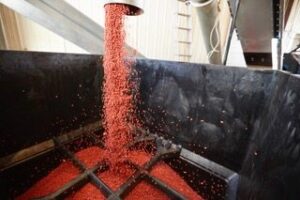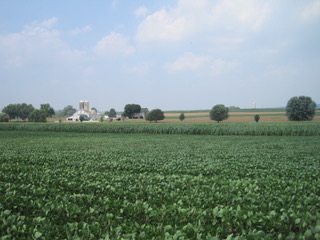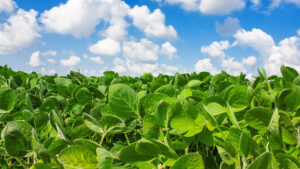Biologicals and chemicals can work together to give growers broader protection, an extended application window, and better management of resistance and residue.
Our food supply is facing new challenges that can only be met with new agricultural solutions.
The world’s population will reach 10 billion in the next 40 years. By then, agricultural production will have to double, pressuring farmers to increase yields and expand the growing season. This exposes crops to more diseases, insects and other pests.
That’s where biological crop protection comes in.
Biologicals are an important technology for crop protection that complements chemistry- based solutions over the full cropping cycle.
Biological crop protection agents such as biological fungicides and insecticides help reduce the damage caused by diseases and pests including fungi, insects and slugs.
Biological crop protection products are derived from natural extracts and living organisms such as beneficial bacteria, fungi, nematodes and insects.
By leveraging chemistry and biology, BASF biological help growers become more productive.

“It’s a natural complement that protects the farm, and farming’s, future,” says Mark Howieson, global biological seed solutions R&D team leader for BASF Functional Crop Care.
Around the world, growers are already using biological to help increase crop quality and yield potential, as well as meet consumers’ evolving expectations.
Biologicals are available for foliar, seed and soil applications.
Like chemical products, they employ a wide range of modes of action.
Complementary
“The real value of biological is that they’re complementary,” says Howieson.
“Biologicals and chemicals can work together to give growers broader protection, an extended application window, and better management of resistance and residues.”
Another advantage of bio control products is that they usually don’t work on a single site of action, but instead attack pests in multiple ways, reducing the potential for resistance to develop.
BASF’s Vault¬® HP liquid rhizobium inoculant and patented rhizobia growth extender, for example, stimulates root nodulation and can also extend the window of disease protection up to 45 days beyond base protection of a seed-applied fungicide.
“In the years to come, farming will be shaped by the kind of innovative approach that BASF’s biologicals provide. By leveraging chemistry and biology, we help growers become more productive,” Howieson says.
Consumers are demanding food with fewer chemical residues and producers are consistently seeking ways to preserve the effectiveness of their pest control tools.
BASF has developed a biological product lineup that provides growers with foliar and drench applied crop protection solutions to help with residue and resistance management.
These tools help control a variety of pests and diseases, often in combination with crop protection products, for both greenhouse and open field growers when used as part of integrated management programs.
Several BASF biological fungicides and insecticides are registered, or in the process of being registered, in multiple countries.
“A strong R&D pipeline will lead to many more exciting products in this portfolio,” Howieson says.
Biological Basics

Biologicals used in agriculture are microscopic organisms, usually bacteria, fungi or yeast. They can also be naturally occurring substances derived from plant extracts or hydrolyzed proteins and amino acids. The soil provides an ideal environment for biological seed treatments to grow and become part of the root’s rhizobiome and available to be absorbed by the roots.
Close proximity to emerging roots gives seed treatment biologicals a head start.
Biological products are effective as they can assist in reducing plant damage caused by pathological fungi and other pests.
They can also enhance nutrient availability and uptake which improves overall productivity and health of the crop.
Common Biologicals
Bacillus thuringiensis (Bt) is a widely-used biopesticide that was discovered in 1901 by Japanese biologist. Bt produces a protein that damages digestive systems of targeted insect pests. Trichoderma is a genus of fungi present in all soils. The genomes of several Trichoderma species have been sequenced and are publicly available. Mycorrhizae is a fungal biological forms symbiotic relationship with plants. It creates an extensive hyphal network in the soil, while exchanging phosphorus for carbohydrates.
Pyrethrin is an insecticidal compound derived from chrysanthemum plants. Its application results in loss of motor control and paralysis of targeted insects.
Humic substances refer to humic and fulvic acids that are derived from humus and commonly used as biological soil supplement.
Using Biologicals
Seed-applied biological function to promote and enhance plant growth in several ways. As a biostimulant they enhance plants’ abiotic stress tolerance and promote extensive fungal hyphal networks in the soil. These long, filamentous structures are the main mode of fungal vegetative growth. They function to solubilize phosphorus to enhance plant growth.
As a biofertilizer, biological can increase the availability of nutrients for plant uptake from the rhizobiome immediately surrounding plant roots.
Rhizobial nitrogen fixation enables soybeans and other legumes to convert atmospheric nitrogen into ammonia for use by plants in exchange for carbohydrates.
Biopesticides also function to control microscopic parasitic pests. By stimulating a plant’s native defense systems, biologicals can trigger a “vaccine-like” response in treated plant to provide protection against microscopic parasites.
“The takeaway is that seedapplied biologicals including both microbials and naturally occurring substances commonly exhibit multiple functions.
They can function as biostimulants, biofertilizers or biopesticides,” Howieson says.
“Biologicals complement conventional crop inputs to help crop plants more fully achieve their maximum genetic yield potential.”












